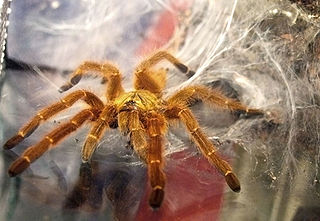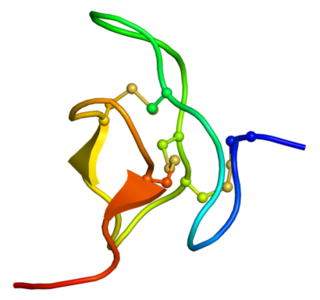Cyriopagopus hainanus is a species of spider in the family Theraphosidae (tarantulas), found in China. It is one of a number of species from China and Vietnam known as "Chinese bird spider". It produces a venom containing numerous compounds capable of blocking neurotransmitters, including neurotoxic peptides called hainantoxins.

Pterinochilus is a genus of baboon spiders that was first described by Reginald Innes Pocock in 1897.

Agatoxins are a class of chemically diverse polyamine and peptide toxins which are isolated from the venom of various spiders. Their mechanism of action includes blockade of glutamate-gated ion channels, voltage-gated sodium channels, or voltage-dependent calcium channels. Agatoxin is named after the funnel web spider which produces a venom containing several agatoxins.

Spider toxins are a family of proteins produced by spiders which function as neurotoxins. The mechanism of many spider toxins is through blockage of calcium channels.

Phrixotoxins are peptide toxins derived from the venom of the Chilean copper tarantula Phrixotrichus auratus, also named Paraphysa scrofa. Phrixotoxin-1 and -2 block A-type voltage-gated potassium channels; phrixotoxin-3 blocks voltage-gated sodium channels. Similar toxins are found in other species, for instance the Chilean rose tarantula.
Phaiodotoxin (PhTx1) is a toxin from the venom of Anuroctonus phaiodactylus, also known as the Mafia scorpion. It affects voltage-gated sodium ion channels leading to an increased duration of its opening.
Raventoxins are neurotoxins from the venom of the spider Macrothele raveni.
Hainantoxins (HNTX) are neurotoxins from the venom of the Chinese bird spider Haplopelma hainanum. Hainantoxins specifically inhibit tetrodotoxin-sensitive Voltage-gated sodium channels, thereby causing blockage of neuromuscular transmission and paralysis. Currently, 13 different hainantoxins are known, but only HNTX-I, -II, -III, -IV and -V have been investigated in detail.
Huwentoxins (HWTX) are a group of neurotoxic peptides found in the venom of the Chinese bird spider Haplopelma schmidti. The species was formerly known as Haplopelma huwenum, Ornithoctonus huwena and Selenocosmia huwena. While structural similarity can be found among several of these toxins, HWTX as a group possess high functional diversity.
Covalitoxin-II is a peptide toxin that is produced by the spider Coremiocnemis validus. It can induce excitatory, non-lethal behavioral symptoms like quivering and jerking in crickets.

Cupiennius salei, commonly called the tiger wandering spider, is a large spider belonging to a group of wandering spiders found in Central America, although this species is specifically from Eastern Mexico, Guatemala, Belize and Honduras. The species was accidentally introduced into Germany in the early 20th century from banana plantations in Central America. In the mid-1950s it was realised that the spider is an ideal model for biological research because of its large size, inactive behaviour, and ease of breeding in laboratories. From an initial 1963 publication on its biological characteristics, it has become the most studied species of spider. Furthermore, the spider is now known to produce a complex neurotoxic venom, such as cupiennins and CSTX, of which a peptide called CsTx-1 is highly potent for paralysing its prey. Its toxin has also become one of the most studied among those of venomous spiders. As the spider does not produce a web for trapping prey, being venomous is its primary strategy for prey capture. It is known to prey on a wide range of insects and small vertebrates.
CSTX is a name given to a group of closely related neurotoxic peptides present in the venom of the wandering spider Cupiennius salei. There are twenty types so far described for this protein group. However, some are reclassified into cupiennins group of toxin, including CSTX-3, -4, -5, and -6, because of their chemical affinity. The first thirteen were isolated and identified in 1994 by Lucia Kuhn-Nentwig, Johann Schaller, and Wolfgang Nentwig of the Zoological Institute at the University of Bern, Switzerland. The different types are most likely the products of splicing variant of the same gene. They are all L-type calcium channel blockers, and also exhibit cytolytic activity by forming an alpha-helix across the cell membrane in mammalian neurons. They also inhibit voltage-gated calcium channels in insect neurons.
Cupiennins are a group of small cytolytic peptides from the venom of the wandering spider Cupiennius salei. They are known to have high bactericidal, insecticidal and haemolytic activities. They are chemically cationic α-helical peptides. They were isolated and identified in 2002 as a family of peptides called cupiennin 1. The sequence was determined by a process called Edman degradation, and the family consists of cupiennin 1a, cupiennin 1b, cupiennin 1c, and cupiennin 1d. The amino acid sequences of cupiennin 1b, c, and d were obtained by a combination of sequence analysis and mass spectrometric measurements of comparative tryptic peptide mapping. Even though they are not strong toxins, they do enhance the effect of the spider venom by synergistically enhancing other components of the venom, such CSTX.
Oxyopes takobius is a species of spiders in the genus Oxyopes of the lynx spider family, Oxyopidae. The species was first described in 1969, and is found from Central Asia to China. Its venom contains a peptide toxin called oxyopinin, which was discovered in 2002.

Oxyopes lineatus is a species of spider in the family Oxyopidae, the so-called lynx spiders.
Apomastus schlingeri is a species of venomous spiders belonging to a family of trapdoor spiders. They produce a complex of neurotoxins called aptotoxins. Both known species of the genus are found in the United States.
Plectreurys tristis is a species of venomous spiders commonly known as primitive hunting spiders belonging to a family of plectreurid spiders. They produce a venom that contains a group of insecticidal peptides called plectoxins. They are found in western North America, Central America and Mexico.

Pacifastin is a family of serine proteinase inhibitors found in arthropods. Pacifastin inhibits the serine peptidases trypsin and chymotrypsin.
Agelenin, also called U1-agatoxin-Aop1a, is an antagonist of the presynaptic P-type calcium channel in insects. This neurotoxic peptide consists of 35 amino acids and can be isolated from the venom of the spider Allagelena opulenta.

Spooky toxin (SsTx) is a small peptide neurotoxin. It is found in the venom of Chinese red-headed centipedes, also known as golden head centipedes. It is originally composed of 76 amino acids, with a molecular weight of 6017.5 Daltons, but loses 23 residues and becomes 53 residues long. As of today, SsTx is unique to Scolopendra subspinipes mutilans.







